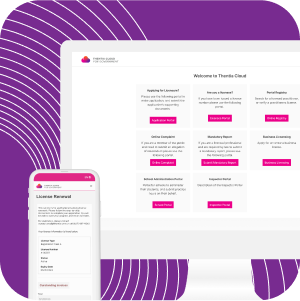Offering complainants a form that is easy to find and submit is an important component of a regulator serving the public interest. Regulators exist to protect the public, and having an accessible means for the public to voice their concerns is a vital step in this mandate. Almost all regulators have some mechanism for receiving complaints from the public about their licensees. Identification is the first and perhaps most important step of this process.
Identification
i) Identify the licensee
Identifying the licensee is paramount. If a complaint form contains nothing else, it needs to allow a regulator to identify whether the target of the complaint is one of their licensees. Although the registration number is a unique identifier, it is not uncommon for a complainant not to have this information. Therefore, a combination of information may be needed to correctly identify the licensee. Regulators may have several potentially identifying data which they may include on a complaint form to help zero in on the intended subject licensee.
However, exact identification is not always possible and may require a regulator’s follow-up to attain more information from the complainant. In other cases, a complainant may simply not know the name of the licensee. For example, a complainant may not know the name of one of the many health professionals that attended to them during an emergency room visit. A regulator, at times, must undertake a mini-investigation to attempt to identify the licensee.
ii) Identify the complainant/person harmed
This leads to the second key piece of information: the complainant’s identification. When a licensee cannot be identified from complaint data, the complainant is the best source to provide valuable information about the licensee. Although it may seem beneficial to allow persons who might fear retaliation to proceed with a complaint anonymously, a regulator’s ability to review and investigate is hindered by practical and legal considerations.
Principles of procedural fairness require a licensee to be given notice and opportunity to respond to the case against them. Without identification, the licensee can not respond, and evidence cannot be gathered. A potential complainant who does not want to provide their name should be directed to contact the regulator directly to explore other options. It is also important to ascertain whether the complainant is complaining about services they received or if they are complaining on behalf of someone else.
Preliminary information
iii) Enable an initial assessment of the issues
The complaint form is essentially the first time the complainant can tell their story to the regulator. A complaint form can provide some concise guidance as well as separate spaces for the complainant to provide the who, when, and what happened. It can assist some complainants in organizing their thoughts. Of course, the narrative abilities of complainants vary wildly, with some complaints providing a very clear and linear story and others lacking coherence and structure, making it harder to identify the issues at play.
Whether or not a complainant lays out a clear story is inherently not within the control of the regulator at first. The principle is to give some space for the complainant to tell their story and many do it in a manner that allows the regulator to identify some of the key issues. Even still, a fulsome assessment almost always requires a follow-up call with the complainant.
Available evidence
iv) Enable a cursory assessment of available evidence
This can be accomplished in a few ways. First, allowing the complainant to upload a variety of documents is one way to assess the available evidence. However, in some cases, the complainant may not possess certain documents, such as their health record, or they may provide irrelevant evidence. Some regulators do not put a limit on how much a complainant can provide, particularly through online complaints, while other regulators may place a limit.
Some regulators may wish to have the chance to speak to a complainant first about what information they have in their possession and make specific requests from there. In such a case, a complaint form could simply ask, in check-off form, if the complainant has certain information or documentation in their possession. Providing a space for the complainant to identify witnesses is also useful. Generally, this may only include a witness’ name and/or their relationship to the complainant or the incident.
Attestations & notices
v) Establish accuracy/truthfulness
The complainant must first acknowledge and attest to the truth and accuracy of their complaint. This may not, as we know, eliminate embellishments or misunderstandings, but it does provide them an opportunity, however brief, to reflect. More importantly, it puts them on notice that truthfulness matters. A complaint found to be full of untruths is unreliable and unreliable evidence leads to unfruitful investigations. The complaint form, and the story told within it, is a piece of evidence that can be tested against any future statements by the complainant.
vi) Notify complainants of disclosure requirements
This acknowledgement, also normally a check-off box, can fulfill two purposes, although it is only directed at one: to notify the complainant their complaint may/will be disclosed to the licensee. The regulator must seek legal consent from the complainant to disclose such confidential information that may be contained within the complaint.
This acknowledgement also signals to the complainant that the process is not wholly confidential or that the process is concluded by clicking the “submit” button. While disclosure may cause some complainants not to submit, obtaining consent to disclosure is a necessity. If a complainant has concerns over their safety, they should be encouraged to call the regulator directly to discuss these concerns. This encouragement can be outlined on a regulator’s website.
The complaint form is one of the first, most important elements in the process of reactive regulation. By hitting a certain set of criteria in designing and processing complaint forms, regulators can make sure they have all the information necessary to proceed with a fair and thorough investigation—one that is fair to both the complainant and the complaint subject. Read more in our whitepaper on the goals and principles of complaint forms in regulation, linked below.













